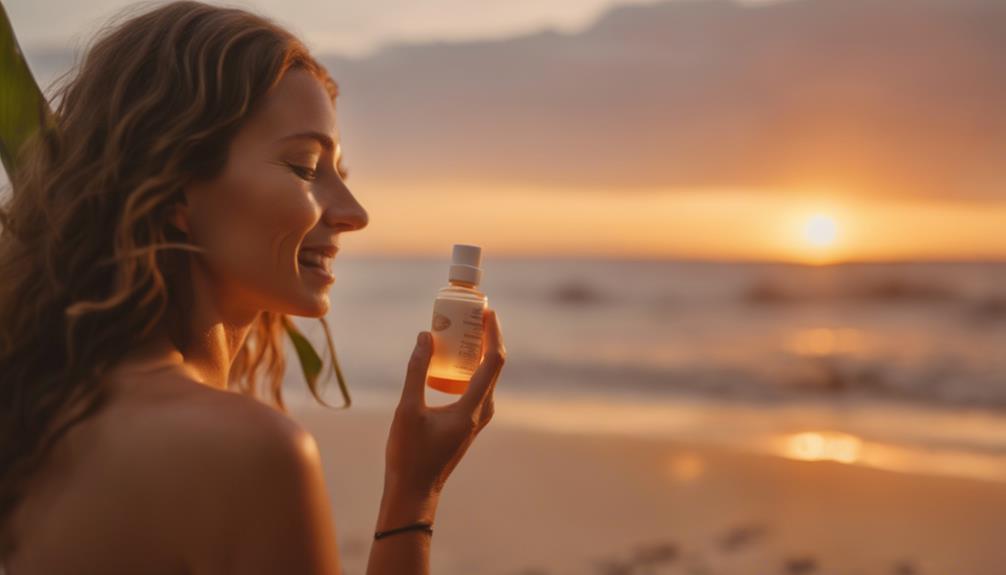For the best tanning bed experience today, make sure to know your skin type and choose the appropriate tanning bed level. Prior to your session, always exfoliate for a more even tan and refrain from wearing makeup to protect your skin. Utilize a suitable bronzer to enhance your color and don’t forget to wear goggles for eye protection. Increase your tanning time gradually while closely monitoring your skin’s reaction. Following your session, moisturize with a non-oil moisturizer and avoid hot showers. Remember, maintaining a consistent skincare routine is essential for preserving your tan, and there’s more to explore that can help you shine!
Key Takeaways
- Determine your skin type and consult a Tanning Bed Time Chart for a personalized schedule.
- Exfoliate your skin a day before tanning for a smooth, even application.
- Apply a tanning lotion before your session to enhance results and reduce burns.
- Always wear specialized goggles to protect your eyes from harmful UV rays.
Understanding Your Skin Type
To get the most out of your tanning bed experience, you first need to understand your skin type and how it reacts to UV exposure.
If you have fair skin (Type 1), you're highly sensitive to UV rays and should take extra precautions.
Use a Tanning Bed Time Chart to create a personalized tanning schedule; overexposure can lead to burns, so it's essential to monitor your skin's reactions.
Before tanning, exfoliate to remove dead skin cells and guarantee an even tan.
Avoid makeup, jewelry, and strong scents, and apply SPF lip balm to protect your lips.
Keep track of your tanning habits, gradually increasing your sessions to prevent skin damage and achieve the best results safely.
Choosing the Right Bronzer
Selecting the right bronzer can greatly enhance your tanning results by complementing your skin type and maximizing your faux glow. Start by identifying your skin tone, as different bronzers cater to various needs.
Here's a quick guide to help you choose:
| Bronzer Type | Best For |
|---|---|
| Lotion | Even application, beginners |
| Spray | Quick application, on-the-go |
| Gel | Intense color, experienced users |
Always test bronzers on a small patch to avoid reactions. Apply evenly, gradually building color to prevent streaks. Consulting tanning professionals can provide personalized recommendations. With the right bronzer, you'll achieve that coveted sun-kissed look!
Tanning Bed Options

Tanning bed options vary in intensity and features, allowing you to customize your tanning experience based on your skin type and desired results.
Level 1 beds offer a gentle introduction, perfect for beginners, with longer sessions needed for ideal results.
If you're looking for a deeper tan, Level 2 beds provide a balanced mix of UVA and UVB rays.
For those seeking quick, intense color, Level 3 beds deliver fast results but require caution due to increased skin damage risk.
Start with shorter sessions, like 5-7 minutes, and gradually increase your time while monitoring your skin's response.
Always remember to follow recommended intervals between sessions to guarantee your skin stays healthy and your tan remains even.
Safe Tanning Practices
While enjoying the sun or a tanning bed, prioritizing safe tanning practices is essential to protect your skin from damage.
Start by determining your skin type and use a Tanning Bed Time Chart to customize your tanning schedule. Exfoliate a day before your session to guarantee an even tan, and avoid makeup, jewelry, or heavy scents.
Always apply tanning lotion before entering the bed, as it enhances your tan while minimizing burns. Gradually increase your tanning time, monitoring your skin's response closely.
Stay hydrated to support skin health, and maintain a consistent skincare routine to prolong your tan. Remember, moderation is key; overexposure can lead to lasting damage, so always listen to your skin.
Eye Protection Essentials

Protect your eyes by always wearing specialized goggles during tanning bed sessions to block harmful UV rays and prevent long-term vision damage.
Don't underestimate the importance of eye protection; the UV radiation can cause serious eye issues, including cataracts and macular degeneration.
Make certain to choose goggles specifically designed for tanning beds, as regular sunglasses won't offer adequate protection.
Always check the fit to ascertain they sit snugly and comfortably.
Replace your goggles regularly to maintain their effectiveness, as wear and tear can compromise their protective qualities.
Remember, your eye health is just as important as achieving that perfect tan.
Prioritize your vision by committing to proper eye protection every time you step into the tanning bed.
Post-Tanning Skin Care
After your tanning session, it's essential to hydrate your skin with a non-oil based moisturizer to help maintain that beautiful glow. This step prevents dryness and keeps your tan looking fresh. Avoid hot showers immediately after tanning, as they can strip moisture. Instead, wait at least a few hours before washing your skin.
Here's a quick guide to post-tanning care:
| Step | Action | Purpose |
|---|---|---|
| Hydrate | Apply non-oil moisturizer | Retain moisture and glow |
| Avoid Hot Showers | Wait a few hours | Preserve tan |
| Use Tan Extender | Apply daily | Enhance and prolong color |
| Exfoliate Gently | Use a soft scrub weekly | Maintain an even skin tone |
Maintaining Your Tan

To keep your tan looking vibrant, it's crucial to establish a consistent skincare routine that nourishes and hydrates your skin. Here are some tips to maintain your gorgeous glow:
- Moisturize Daily: Use a non-oil based moisturizer to keep your skin hydrated and extend your tan's life.
- Avoid Hot Showers: Steer clear of hot showers immediately after tanning; opt for lukewarm water to preserve your color.
- Exfoliate Gently: Exfoliate once a week to remove dead skin cells without stripping away your tan.
- Stay Hydrated: Drink plenty of water to support overall skin health and maintain that bronzed look.
What Are the Best Tips for Maximizing Your Tanning Bed Experience?
When looking to maximize your tan before vacation, it’s important to properly prepare your skin. Exfoliate to remove dead skin cells, apply a good quality tanning lotion, and wear protective eyewear. Start with shorter sessions and gradually increase the time to avoid burning. Moisturize regularly to help your tan last longer.
Conclusion
In your quest for that perfect tan, remember it's all about preparation and safety.
By understanding your skin type, selecting the right bronzer, and practicing safe tanning, you can achieve a glow that rivals the sun itself—without ever stepping outside.
Embrace the journey and cherish those moments when you catch your reflection, feeling like a golden goddess.
So, get out there and maximize your tanning bed experience today; your radiant future self will thank you!










